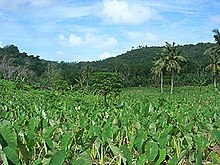Vaitogi, American Samoa
Vaitogi | |
|---|---|
Village | |
| Etymology: Tuālāuta | |
| Area | |
| • Total | 1.25 sq mi (03.25 km2) |
| Population (2010) | |
| • Total | 1,959 |
| • Density | 1,600/sq mi (600/km2) |
| Demonym | Vaitogian |
| Time zone | Samoa Time Zone |
| ZIP code | 96799 |
| Area code | +1 684 |
Vaitogi is a village in
It is home to Tessarea Vaitogi Inn, which is a hotel in town.[3][4]
Etymology
Although there is no specific account of the name’s origin, the name may be related to the lack of water in the area, according to oral tradition. The name Vaitogi translates to “water thrown”.[5]
History

Vaitogi was first located in the
Vaitogi was visited by Robert J. Maxwell in 1965-1966, who sampled 52 participants in a 22-month research project inspired by the theories of Hans Eysenck concerning Extraversion and introversion behavior.[7]
Vaitogi villagers gather once every year to commemorate an incident that happened over a century ago. At one point, a fire raged through the village for days and could not be extinguished, threatening lives and destroying scores of hectares of vegetation and crops. After the village chiefs gathered to pray for the fires to end, heavy rain supposedly fell extinguishing the flames. The village observes a 24-hour curfew once per year to mark the event.[8]
Toeupu of Vaitogi became the first person to be convicted and hanged for murder in American Samoa. Toeupu was assassinated on July 1, 1921, for killing Sake of Leone over a gambling debt.[9] Toeupu armed himself with a shotgun and sought out Sake of Leone, whom he fired upon and killed. He was arrested and brought to trial eleven days later. He confessed his guilt and was sentenced to be hanged. California lawyer C.S. Hannum found the execution of a self-confessed killer, only 26 days after the commission of the crime, to be intolerable. He complained to President Calvin Coolidge about the “illegal hanging of a Samoan.”[10]
Margaret Mead
| Year | Population[11] |
|---|---|
2010 |
1,959 |
2000 |
1,347 |
1990 |
1,302 |
1980 |
664 |
1970 |
473 |
1960 |
409 |
1950 |
421 |
1940 |
235 |
1930 |
217 |
Archaeologist
She also described her stay: “It was there [in Vaitogi] I had all my essential training in how to manage Samoan etiquette… I learned to eat and enjoy Samoan food and to feel unabashed when, as a guest, I was served first and the whole family sat about sedately waiting for me to finish so that they, in turn, could eat… Day by day I grew easier in the language, sat more correctly… I learned how to relate to other people in terms of their rank and how to reply in terms of the rank they accorded me."[14]
Geography
Vaitogi is located on the southern tip of
Economy
Vaitogians have been traditionally known to be skilled farmers, and the large flatlands toward inland Vaitogi were a great advantage for the farmers. Vaitogi is also notable for its past sugar cane fields. The sugar cane leaves were woven into thatches for the roofs of fales (houses). The Vaitogi farmers also planted palm trees to cater to the demands of roof thatching. The products were often sold at the Fagatogo Market. Agriculture was a vital source of income particularly after families began settling further inland. Crops such as cucumber, head cabbage, pineapple, and lime are still brought from Vaitogi to be sold at the Fagatogo Market.[16]
Demographics
Vaitogi was home to 1,347 residents at the
Religion
Vaitogians worshipped in private homes and guest houses of the village chiefs until the church was built in the 1850s. The first Christian denomination to be established in the village was the
Sports
The village’s traditional symbol and icon is Pisisami (sea breeze). The icon is often used in athletic activities and private business. In professional sports, the men’s cricket team has won the islandwide championship title several years, and the women’s cricket team has won the championship in the women’s division.[20]
Landmarks
- Fogāma'a CraterNational Natural Landmark
- Turtle and Shark
Notable people
- Tofilau Eti Alesana, prime minister of Samoa, the longest serving head of a state in the Pacific Ocean.[21][22]
- Gaea Pelefoti Failautusi (1939–2023), former American Samoan Senator[23]
- NFL.
- Sau Ueligiton, artist, lived in Vaitogi for 25 years.[24]
References
- ISBN 9781566914116.
- ^ "Day Hikes" (PDF). National Park Service. Retrieved 30 November 2021.
- ISBN 9780792270287.
- ISBN 9781621280682.
- ISBN 9781546229070.
- ISBN 9781546229070.
- ISBN 9780897891622.
- ^ "American Samoa village observes annual 24 hour closure". RNZ. 17 September 2008. Retrieved 30 November 2021.
- ISBN 9781573062992.
- ISBN 9780405130380.
- ^ "American Samoa Statistical Yearbook 2016" (PDF). American Samoa Department of Commerce.
- ISBN 9780190283490.
- ISBN 9780299234539.
- ISBN 9780299234539.
- ISBN 9781546229070.
- ISBN 9781546229070.
- ISBN 9781428985490.
- ISBN 9781546229070.
- ISBN 9781546229070.
- ISBN 9781546229070.
- ISBN 9780810842373.
- ISBN 9780824822651.
- ^ "Senate passes Concurrent Resolution offering its condolences to the family of First Lady Ella Mauga". Samoa News. 2023-07-12. Archived from the original on 2023-07-24. Retrieved 2023-07-24.
- ISBN 9780824812386.
